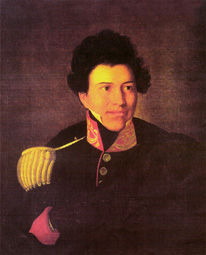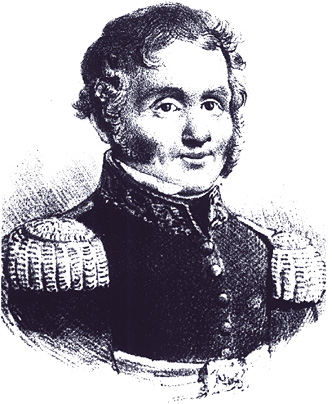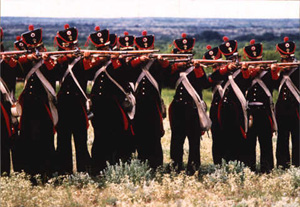
Compañía Granaderos (grenadier company)
Organismo del Ejército Méjico
There are four main branches to the Ejército Mexico Each of these units (except for the artillery) is broken down into three units:
- Operational Army
- Battalions
- Companies
Mexican Infantry Battalions are of two kinds:A Mexican Infantry Battalion is comprised of eight companies.These were:
- Permanente (Permanent or Standing or Regular Army) Battalions, formed in 1823 and reformed in 1833). Between 1823-1833 these were numbered, between 1833-1839 these were named in honor of the heroes of the Mexican War for Independence.
- Activo (active or National Guard) battalions. These were named for the geographical location in which the battalion was originally raised.
By Regulation a Compañía consisted of a capitán (captain), a teniente (lieutenant) two subtenientes (sub-lieutenants), a sargento primero (first sergeant), three segundo (sergeants), eight cabos (corporals) and 83 soldadoes (Bando: 1 Sept. 1824).
- Compañía Cazadores(roughly light infantry rifle company, similar to the French chassueres, also called preferred company). Used as the battalion skirmishers or flankers. Armed with the British Baker Rifle or the British Light Infantry Musket.
- Compañía Granaderos (grenadier company). Pick troops of the battalion used for reserves. Armed with the British East India Pattern musket.
- Compañía Fusileros (Fusilier or line company). There were six of these companies comprised of regular foot soldiers armed with East India Pattern musket.
Each of the fusilero companies were to have two drummers and a fifer, while the cazadores and granaderos were assigned three trumpeters.
The battalion staff (plana mayor) consisted of a colonel (coronel), a lieutenant-colonel (teniente colonel), a first adjutant (primero ayudante) two second adjutant (segundos ayudantes), two sub-adjutant (subayudantes), a chaplain (capellán), a surgeon (cirujano), an armorer (armero), a drum major (tambor mayor), a corporal of drummers and fifers (cabo de tambores y pifanos) a corporal and eight pioneers ( cabo y ocho gastadores) and 2 musicians (musicos).
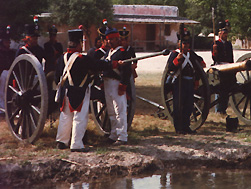
The Mexican Army, from 1833-1839 consisted of ten permanente infantry battalions.These were:
Permanente Hidalgo (named for the priest Miguel Costilla y Hidalgo)
Permanente Allende (named for Ignacio Allende)
Permanente Morelos (named for the priest José Maria Morelos)
Permanente Guerrero (named for Vicente Guerrero)
Permanente Aldama (named for Juan Aldama)
Permanente Landero
Permanente Matamoros (named for Fray Mariano Matamoros)
Permanente Abasolo (named for Mariano Abasolo)
Permanente Jimenez (named for Mariano Jimenez)
Permanente Galeana (named for Hermenegildo Galeana and his brother)There were sixteen activo militia battalions. These were:
Activo Mexico
Activo Cuautitlan
Activo Puebla
Activo Puebla
Activo Tlaxcala
Activo Toluca
Activo Tres Villas
Activo Mextitlan
Activo Guanajuato
Activo Morelia
Activo Guadalajara
Activo Zacatecas
Activo Sur
Activo San Luis Potosi
Activo Queretaro
Activo Oaxaca
Activo CastillaIn addition there were the 3 Yucatan Battalions and the Chiapas Battalion.
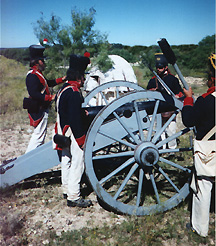
Mexican Artillery
There were also 13 Guarda Costa Compañías consisting of:
Tampico
Tuxpan
Alvarado
Acayucan
Tabasco
Carmen
San Blas
Colima
Zacatula
Acapulco
Ometepec
Jamiltepec
TehuantepecThere was also a standing battalion of Zapadores (Engineers).
The Following Mexican Infantry Units Served in the 1836 Texas Campaign:
Permanente Matamoros
Permanente Jimenez
Permanente Allende
Permanente Aldama
Permanente Guerrero
Activo San Luis Potosi
Activo Toluca
Activo Queretaro
Activo Guanajuato
Activo Primero Mexico
Activo Guadalajara
Activo Tres Villas
Activo YucatanSOCIAL AND ETHNIC BREAKDOWN
The officer corps was broken down into three basic social.ethnic groups:
It was recommended by regulation that the sub-lieutenants be recruited from the experienced Non Commissioned Officers. Others could purchase a commission or receive commission by attendance and graduation from the Military Academy established at Chapultepec.
- Creoles
- Mestizos
- Foráneo
The rank and file were broken down into two basic social/ethnic groups:
There was some foreign enlistment in the ranks but not enough to make a noticeable difference.
- Mestizo
- Indian
The Mexican Army was based on a conscript system. Volunteers could enlist for eight year terms while draftees served ten years. Pay was 19 pesos, four reals and 9 granos per 25 day month.
Mexican Permanente Cavalry Regiments1833-1839, Named for the Battlefields of the Wars for Independence
Tampico RegimentMexican Cavalry Regiments at the Siege of the Alamo
Dolores Regiment
Veracruz Regiment
Palmar Regiment
Iguala Regiment
Cuautla RegimentPermanente Dolores RegimentMexican Cavalry Regiments during the Goliad Campaign
Elements of the Rio Grande Presidial CompañíaPermanente Tampico Regiment
Permanente Cuautla Regiment
Guanajuato Territorial Regiment
Victoria Guards (Carlos de la Garza's Company)
Guadalupe de los Santos Racheros
OFFICERS OF THE MEXICAN ARMY
Juan N. Almonte
Almonte, Juan N.
Almonte was a colonel on Santa Anna's staff who presented Mexican surrender demands to Green B. Jameson on February 23, 1836. He was captured at San Jacinto, but later released. Almonte was the illegitimate son of Mexican revolutionary hero the preist Juan Morelos. A career army officer and politician, Almonte served in numerous staff and governmental positions including the Ambassadore to the United States in 1845, briefly Secretary of War during the US-Mexican War and was among the former Centralists who supported the French occupation of Mexico in 1862. Almonte served as a minister in the Mexican Imperial Government before fleeing to France, where he died in Paris, on March 21, 1869.
Amador, Juan Valentín
Brigadier-General who led the first Mexican troops over the northern defenses of the Alamo. Born in Cuba in 1781, he served in the Spanish lancers until joining the Army of the Three Guarantees under Iturbide. Promoted to brigadier-general in 1831. He died in 1851.Ampudia, Pedro
Lieutenant Colonel in command of the Mexican artillery during Alamo siege. He participated in the assault. Ampudia was a native of Cuba who later commanded both the Mexican troops at the battle of Mier in 1842 and the Mexican Ejercito del Norte in 1845-46. He participated as a division commander at the battles of Palo Alto and Resaca de la Palm. He also commanded Mexican troops at the Battle of Monterey. During the French Intervention, Ampudia served in Juarez's Army. He died on August 7, 1868 and was buried at the Panteon de San Fernando.
Amat, Augustin
Colonel of the Zapadores Battalion. Was second in command of the Mexican reserves during the Alamo assault.
Andrade, Juan José de
Brigadier-General in command of the Mexican cavalry brigade. He was commander of the Alamo and San Antonio from March 11-May 30, 1836 and responsible for the demolition of the Alamo defenses. Native of Mexico, born in 1796, he joined the Spanish Army in 1809, serving in the Regiment Provincial Durango. Andrade joined the Army of the Three Guarantees and Iturbide. After Texas War, he served as commandant-general of Puebla. He died in 1843.
Aquiree, MiguelColonel who commanded Santa Anna's cavalry escort at San Jacinto. He was killed at San Jacinto.
Arago, Juan
Major General, nominal third in command of the Ejercito de Operaciónes. Born in Pirinoes Greentales, France in 1788, he joined the Spanish Artillery before defecting to the revolutionary forces of Xavier Mina and later joined him on his expedition in Mexico (1817). He died in 1836.Bringas, Juan María
Colonel on Santa Anna's staff.
Bustamente, Anastacio
Centralist General who was made president of Mexico in 1830 following a revolt against Federalist President Vicente Guerrero. A Federalist revolt under Antonio Lopez de Santa Anna removed him from office in 1832. Bustamante became president of Mexico again in 1837 until overthrown again by Santa Anna. Under Bustamente, the Laws of April 30, 1830 were enacted and the uprisings at Anahuac and Velasco took place.
Canedo, Manuel
Bvt. General, commanding the Activo Guadalajara. Native of that state, born 1782. Served in Spanish Infantry before joining the Army of the Three Guarantees. Died in Jalisco in 1855.
Castrillion, Manuel Fernandez
General. was aide-de-camp to Santa Anna who served as second-in-command of Duque's assault column on the Alamo assault. Killed while trying to rally Mexican troops at San Jacinto. Buried in the de Zavala Family Cemetery.
Cespedes, Manuel
Colonel, commanding the Permanente Guerrero Battalion. Captured at San Jacinto and later escaped. Adjutant-general of Plana Mayor in 1846.
Condelle, Nicolas
Colonel commanded the Permanente Morales. Second-in-command of Mexican troops at the siege and battle of Bexar. Born around 1790 and served in Spanish military before joining the independence movement. Served on the military court-martial which executed former President and hero of the War for Independence Vicente Guerrero. Died around 1846.
Martin Perfecto de Cos
Division-General, Commander of the Eastern Interal Proviences. Commanded Mexican forces in Texas from September 18-December 10, 1835. Defeated at the battle of San Antonio de Bexar, December 10, 1835. Commanded the first assult column at the Alamo battle. Captured at San Jacinto and later released. Cos was born in 1800, served in the Fijo de Vera Cruz Regiment before joining the Army of the Three Guarentees under Iturbide. Commanded defenses south of Vera Cruz during the US invasion of 1847. Died October 1, 1854 at Minatittan. Was Santa Anna's brother-in-law.Duque, Francisco
Colonel, commanding the Activo Battalion Toluca. Commander of the north assult column in Alamo battle in which he was wounded in the leg. Native of Cocila, Jalisco, born 1792. Promoted colonel in 1830. Was later commandant general of Sonora and Sinaloa before his death in 1854.
Dromundo,__________
Quartermaster General of the Ejercito de Operaciónes.
Farias, Gomez
Leader of the Mexican Federalists. Was Santa Anna's vice-president in 1832. When Santa Anna "retired", Farias assumed the presidency and enacted a series of reforms against the upper class and the Catholic Church, which enraged the Mexican Centralists. Santa Anna proclaimed the Plan of Cuernavaca in 1834, which called for the removal of Farias and the 1824 Constitution and the establishment of a centralist government. Farias remained an active Federalist and would again assume the presidency in 1847. Under Farias first administration, Stephen Austin was arrested and the California missions were secularized.
Vicente FilisolaFilisola, Vicente
Second in command of the Ejercito de Operaciónes. Born Tavello, Italy, in Mexico since the wars for independence. Assumed command of the Mexican Army in Texas after San Jacinto. Court-martialed and later exonerated from wrong doing. Died July 23, 1850.
Gaona, Antonio
Brigadier-General commanding the First Infantry Brigade. After Alamo, commanded division sent up Camino Real towards Bastrop and Nacogdoches. Born 1793 in Cuba. Joined Regiment Nuevo España in 1801. Promoted to general in 1832. Served in US-Mexican War. Died in 1848.
Gonzales, Eulogio
Colonel, adjutant for the vanguard under Sesma.
Guadalupe Victoria
Assumed name of Juan Manuel Felix Fernandez, the first elected president of the Mexican Republic and the only person to serve his complete term of office. Inaugurated on October 10, 1824 with Nicolas Bravo as vice-president, Victoria was a Federalist and under his administration, the Constitution of 1824 was adopted. He served a four-year term.
A town in South Central Texas on the Guadalupe River now the county seat of Victoria County. Founded in 1824 by Martin De Leon, the only Mexican empressario, it was named for President Guadalupe Victoria. The community supported Texas independence and grew in importance during the 1840-1870's.
Pedraza, Manuel Gomez Mexican centralist who was elected president in 1828 with Anastasio Bustamante as vice-president. Pedraza was driven out of the country by a Federalist revolt and the congress declared his election null and void. He was later allowed to finish the term of Bustamente when the later was driven from office in 1832.
Guerrero, Vicente
One of the leaders of the Mexican independence movement who had joined with Iturbide to establish Mexican independence in 1821. Guerrero was elected president in 1829 to replaced the removed Manuel Pedraza. A Centralist revolt removed him from power and he was replaced by Anastasio Bustamente. Guerrero was later captured and tried by a military court who order his execution. Under Guerrero's administration, slavery was abolished.
Infanson, Antonio
Colonel, adjutant to General Gaona.
Iturbide, Agustin de
Creole Royalist Officer who in 1821 issued the Plan of Iguala uniting Royalists and Revolutionaries under the "Three Guarantees": maintenance of the Roman Catholic religion, establishment of an independent constitutional monarchy and equal rights for all Spaniards and Mexicans. Iturbide was successful in securing Mexican independence only to be made Emperor of the short-lived Mexican Empire on July 21, 1822. Pro-republican forces launched a revolt and forced his abdication on March 19, 1823. Exiled, he attempted to return to Mexico only to be arrested and executed in Tamaulipas on July 19, 1824. His remains were later moved to the Mexico City to be buried with the other heroes of the Wars for Independence.
Labastida, Ignacio
Captain at the rank of Bvt. Lieutenant-Colonel. Zapadores Battalion Officer on Santa Anna's staff. Produced on of three Mexican Army maps of the Alamo during the siege. Born in 1806, helped defend Vera Cruz from French in 1838. Died soon afterwards.
Lopez, Jos´e; Reys
Commissary Department Chief
Minon, José Vicente
Colonel, second-in-command of Morales' cazadore column in the Alamo assault. Born in 1802 at Cadiz, Spain. Joined Mexican Independence movement. fighting at the battles of Arroyo Hondo and Azcapotzalco. Later involved in French Occupation of Mexico. Died in 1878.
Montoya, Cayentano
Colonel, commanding Activo Queretero Battalion. Born 1791. Later commandant general of the Departments of Queretero, Guanajuato and Zacatecas. Served as Governor of Queretero. Died in 1868.
Mora, Estevan de la
Colonel, Santa Anna's staff. Killed at San Jacinto.
Mora, Ventura
Colonel, rank of Bvt. General, commanding Permanente Dolores Cavalry Regiment. Native of Esteban Panuco, Tamualipas, born 1796. Served in US-Mexican War. Commandant-general of Zacatecas at the time of his death in 1853.
Morales, Juan
Colonel, commanding Batallion Activo San Luis Potosi. Commanded the combined cazadore company assult column at the Alamo assult. Also was at the battle of the Coleto. Captured at San Jacinto and later released. Born 1802 at Puebla. During the US-Mexican War, commanded the garrison at Vera Cruz which surrendered to General Winfield Scott. Arrested for his actions at Vera Cruz, he was held at Perote Prison until it was captured by the Americans and then released. Died soon afterwards.
Peralta, Agustin
Colonel, adjutant to General Tolsa
Pretulia, Ignacio
Colonel, commanding Activo Guanajuato Battalion
Quintero, Francisco
Colonel, commanding Activo Primero Mexico Battalion. Born 1805 in Puebla. Fought in Juarez's army against the French. Died 1872.
Robelo, José
Treasurer/accountant for the Ejercito Operaciónes
Romero, José Maria Colonel, commanding the Permanente Matamoros Battalion. Commanded the eastern attack column at the Alamo assult. Captured at San Jacinto and later released. Was 38 years of age at the time of the Texas Revolution.
Salas, Mariano
Colonel, commanding Permanente Jimenez Battalion. Second-in-command of Romero's attack column in Alamo assault.
Sanchez-Navarro Jose
Lieutenant-Colonel, inspector and adjutant of the Eastern Northern Provinces. Present at the siege and battle of Bexar and the Alamo. Did two of the three plats of the Alamo during the siege. Was from the wealthiest families in Coahuila. Died at Saltillo in 1849.
Sesma, Joaquín Ramirez y
General, commanding the vanguard of the Ejercito Operaciónes. Commanded cavalry in the Alamo assault as the vanguard of the Mexican army on the march to the Brazos.
Tola, Luis
Lieutenant-Colonel of the Zapadores Battalion. Served as Corps Commander. Born 1802. Later director of the Mexican Military College with which he enjoyed a long association. Died in 1887.
Tolsa, Eugenio
General, commanding the Second Infantry Brigade.
Tornel, José Maria y Mendivil
General and Secretary of War and Navy. Born 1789. Highly patriotic Mexican national, was captured and sentenced to death by Spanish but escaped. Was a leader of the Mexican conservative (Centralist) party. Extremely anti-North American. Noted man of letters involved in higher education of Mexico. Died in 1853. The infamous Tornel Degree was issued under his administration.
Urunuela, Gregorio
Lieutenant-Colonel commanding the Permanente Aldama Battalion.
Urrea, José
Brigadier-General commanding the southern division of the Mexican Army operating against the Texas Gulf Coast and Goliad. Assumed command of Mexican Army following Filisola's replacement in May, 1836. Native of Tuscon, Arizona, son of presidial officer. Served as a cadet in a presidial company. Was pro-Federalist. Served as a division commander in Northern Mexico during the US invasion. Died at Durango in 1849.
